
I love Maine… even if I spent all morning shoveling, hacking, plowing and clearing snow, remnants from the third storm we’ve had in the past six days, even if this weather makes Maine the soul sucking and life energy draining capital of the United States. I believe the state tourism slogan is “Come to Maine… it won’t be crowded”. Fortunately I have a rifle to pick and poke at and eventually use as the subject of one of my insightful pieces into the exciting world of… retail firearms.
What is this gun called the CZ 455?
|
||||||||||||||||||||||||||||||||||||||||||||
The CZ 455 is the replacement model for the CZ 452. Good to know, however, I am not familiar with the CZ 452, so I’ll just begin with the CZ 455 and a total lack of historical context. The CZ 455 is produced in a manner consistent with quality bolt action rimfire rifles made by major manufacturers, the last time manufacturers made quality rim fire rifles… about twenty years ago.
Unfortunately, with the exception of CZ, the expense of making these types of firearms forced some manufacturers to discontinue production of quality bolt action rimfire rifles and others to cost reduced their products until they resembled a piece of pipe and a pile of imprecise stampings, all lashed to a couple of pounds of injection molded plastic with duct tape. Too much? A little over the top? I think perhaps not.
While the CZ 455 is manufactured utilizing the latest manufacturing technology, I know that because the CZ-USA catalogue says so, it retains all of the appearances, materials and precision machine work that makes for a clean looking, reliable and accurate rim fire rifle; attributes I was able to identify on my own.
Some detail. I like a gun I can take apart… and put back together
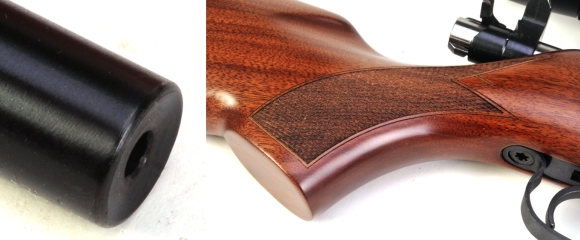
The CZ 455 has a very shallow muzzle angle… more like a target rifle. The crown is deep enough to prevent bump damage to the rifling, but shallow enough to promote uniform pressure on a bullet as it exits. The stock is nicely done. Turkish walnut and laser cut checkering. Winchester should hire CZ as consultants to help them get their current laser cut efforts squared away. The CZ 455 stock’s grain is nice. good contrast. Inletting contact points are cut cleanly, however, non contact points are left a little fuzzy and unfinished. Sealing would help moisture control and minimize wood dimensional changes with changes in relative humidity.
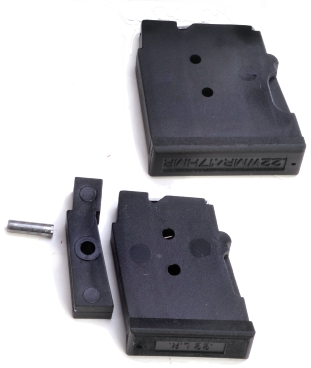
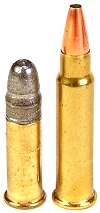
Part of the caliber changing procedure requires swapping magazines. The shorter .22 LR round adds a spacer, bottom far left with pin, that fits into the rifle’s magazine guide.
Both magazines have five shot capacity, ten round magazines are available as extra cost options. The CZ 455 is available in standalone 22 Magnum also, but not as part of a switch barrel configuration. CZ uses the same magazine for both .22 Mag and 17 HMR as they both have the same case head diameter and overall cartridge length.
The CZ 455’s receiver has an integral 11mm dovetail for scope mounting. Within this project I used adapters that convert 11mm dovetail mounts to Weaver standard.
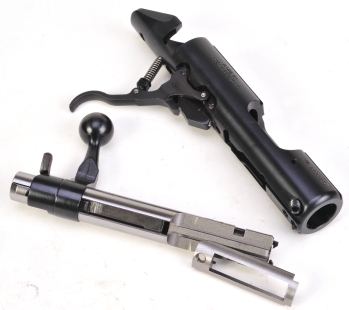
The heart of the CZ 455 is a receiver formed and machined from a steel billet. With a wall thickness of 0.250″, it is heavier than most centerfire rifle and its close tolerance bore makes bolt travel slick, precise and free of wobble. The bolt body is beefy at 0.705″ in diameter. Lock up, as is typical with rim fire rifles, is at the bolt handle. The trigger is adjustable within a range of 3 – 5 lbs.
The small steel piece in the foreground, resting against the bolt, is the gun’s bolt guide. The guide resides in the lower radius of the receiver bore where it is retained by the magazine guide’s fasteners. The guide serves several functions.
A horizontal flat machined into the leading edge of the piece properly locates the gun barrel on its longitudinal axis to assure the barrel’s extractor notches properly align with the extractor hooks in the bolt face. The top surface of the guide prevents the bolt head from rotating as the bolt handle is rotated down which cocks the gun. The 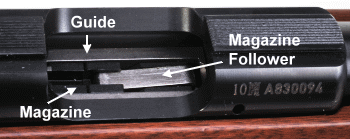 rectangular slot in the guide forms a precision transition from the gun’s magazine to its feed ramp.
rectangular slot in the guide forms a precision transition from the gun’s magazine to its feed ramp.
Nice CZ design touches that make barrel swapping for this combo arrangement a snap, action cycling positive and feed, extraction and ejection reliable with both 22 LR and 17 HMR rounds.
The barrel retention system
Rim fire barrels from the old Nylon 66 Remington to the modern Ruger 10/22 are held in place with screws and some form of locating/locking block. CZ sets headspace with a shoulder machined into the CZ 455’s barrel and locates longitudinally with the help of the gun’s bolt guide. The barrel is retained by two screws threaded through the lower side of the heavy walled receiver. The locating/locking fastener contact surfaces are two adjacent “V” cuts in the lower barrel shank.
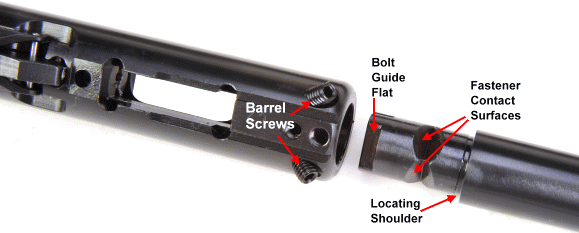
I got as close as I could to measuring the angle on the “V” cuts… seems about 40 and they are splayed and toed inward to follow the barrel screw locations. The V notch approach seems intended to locate the barrel fore and aft and to prevent barrel rotation. If I extend an imaginary line at these angles, they seem to intersect at the rear center of the gun’s chamber.
Point of impact consistency…
I thought for sure there would be a torque spec and sequence to follow for installing the barrel screws and barrel, but there was none listed in the manual or on the CZ or CZ-USA web site. There is, however, a fastener torque spec for the Torx head stock securing fasteners that is spec’d, within the barrel exchange section of the manual, at 6Nm. That’s pretty hefty considering the inch/lb equivalent is 53.10. I removed and replaced the stock a number of times without the aid of a torque wrench. Point of impact shift within a population of the same ammo was negligible. I did, however, find that barrel screw installation did make a measurable difference.
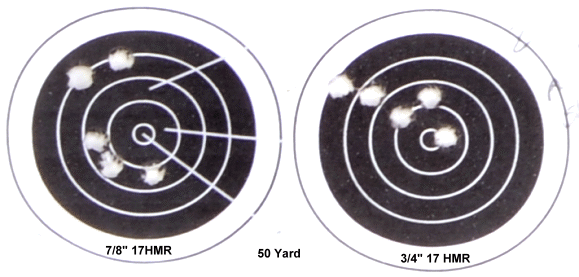
The first group, left, was shot with the .17 HMR barrel freshly installed and three other groups shot, for all intent and purposes, the same. I removed and reinstalled the barrel using a torque wrench set to 20 in/lbs and the guns shot three groups that looked about the same as the group on the right. I removed the barrel and reinstalled again and the point of impact remained essentially unchanged. Removing and reinstalling the barrel without using a torque wrench shifted the group around and almost always had a couple of shots stray away from the rest. Could be a coincidence. In any event, all of the gun’s groups were good. micro strays or not. It was cold, about 10°F and cross wind was mild but gusting.
Since I’m putting up targets anyway…
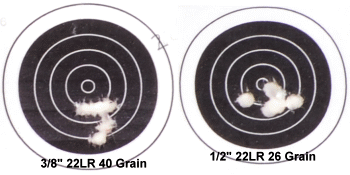
The .22 LR barrel shot pretty much to the same point of impact within a given bullet weight, with only a minor shift with bullet weight/velocity changes.
The 40 grain bullets chronographed 1,342 fps compared to their 1,300 fps rating. The 26 grain loads clocked 1,688 fps to their 1,650 fps rating. The 20 grain 17 HMR rounds clocked 2,526 fps to their 2,375 fps rating.
Overall, I thought the gun’s 22 caliber accuracy was excellent. The 17 HMR not quite as good, but better than most of CZ’s competitors non-target rifles I’ve shot, chambered for the same round.
All and all…
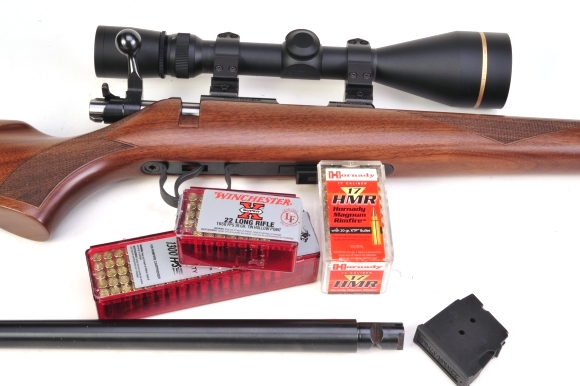
Combo caliber rim fire firearms make a lot of sense. Typically one chamber provide general purpose utility and lots of inexpensive recreational target shooting opportunities. The second chamber provides more power and longer reach at an added cost of ammunition. The CZ 455 as a stand alone .22 LR firearm is an approximately $360 rifle through discount retailers; at about a 50% premium over low end .22 LR rifles, it is at least twice the rifle. No comparison. The CZ 455 combo rifle with both .22 LR and 17 HMR capability, add about another $125. A good way to extend the use of one rifle and an inexpensive way to get the use of two quality gun.
Would I change anything about the CZ 455 American Combo? Two issues and they are both minor and aesthetic in nature. I would clean up the stock inletting and seal the wood. The gun is too nice to have this minor rough edge. I’d add $10 to the price and replace the stamped steel trigger guard with something a hair more substantial, but nothing that would effect the rifle’s excellent 5 lb 10 oz light weight. Other than that, I wouldn’t touch a thing.

Email Notification